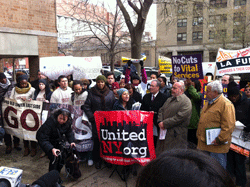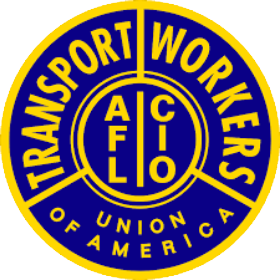Headed for Fiscal Cliff? Groups Fear for the Future
 November 9, 2012
November 9, 2012
By Marc Bussanich
Thousands of New Yorkers are still without power more than a week after Hurricane Sandy struck. In the Rockaways, Sea Gate, Coney Island and the Lower East Side, working families are struggling without electricity and seeking shelter. The relief efforts underway underscore the importance of federal dollars in a crisis. However, the deadline for across-the-board cuts to federal programs, the “fiscal cliff,” is approaching, and unless Congress enacts a balanced, long-term reduction plan before January the cuts will adversely impact struggling New Yorkers.
The Budget Control Act of 2011 was finally passed to raise the debt ceiling to prevent the country from defaulting on its debt. The caveat, however, is $1 trillion worth in cuts to the federal budget over 10 years and the establishment of a joint committee of Republicans and Democrats to identify an additional $1.2 trillion in spending cuts and/or revenue increases over 10 years.
To bring attention to the impending “fiscal cliff,” community groups, elected officials and union members gathered and spoke at Campos Plaza in the Lower East Side, across the street from the crippled Con Ed substation.
Manhattan Borough President Scott Stringer presented some of the findings of a newly issued report, The Fiscal Cliff: How Looming Program Cuts and Tax Hikes Could Affect New York City Residents, co-authored with Congresswoman Carolyn Maloney’s and Congressman Jerrold Nadler’s offices.
“Hurricane Sandy reminded us how vulnerable we are to Mother Nature. New York faces the prospect of over $800 million in cuts. Agencies such as NYCHA and the DOE would see a loss of $102 million and $75 million in federal funds, respectively,” said Stringer.
The cuts in federal programs are to be accompanied by tax increases. According to the report, taxes would rise by $536 billion in 2013—an average of almost $3,500 per household. Taxes for families in the bottom 20 percent of income distribution will increase by an average of 3.7 percent, while middle class families will lose 4.4 percent of their income, or about $2,000.
As devastating as Hurricane Sandy was, elected officials said that the storm and the re-election of President Obama has presented an opportunity for the federal government to commit itself to rebuilding communities in the city and across the country.
Council member Gale Brewer was the director of the NYC Office of Federal Relations under David Dinkins’s administration and witnessed the changes in federal support for urban centers when Clinton’s presidency yielded to George Bush.
“There’s an opening now because people see there’s a dire need and it could happen to them. I’m hoping that’s the silver lining we can see. I don’t think that really happened with New Orleans, unfortunately. People thought maybe that was an isolated case, but now the entire seaboard is affected,” said Brewer.
“We can take this tragedy and turn it into an opportunity to create middle class jobs and put people back to work, particularly those in public housing who, unfortunately, have been suffering for a very long time. It’s time for the President to be bold and brave to invest in NYCHA and other public facilities,” said Council Member Leticia James.
Stuart Appelbaum, president of the Retail, Wholesale and Department Store Union, said as his members are struggling to survive in the wake of Sandy, there’s an economic storm strengthening.
“We’re still paying a high price for three decades of rampant Wall Street speculation. Our infrastructure is literally crumbling and our safety net is disappearing. As we go about rebuilding, the only successful approach is a wage-led recovery. Our country and economy can only be successful when we include everybody.”
Anthony Feliciano, a member of Good Old Lower East Side, a neighborhood housing and preservation organization dedicated to tenants’ rights, was one of several thousand volunteers helping vulnerable residents in the wake of Sandy.
“There were people biking in from Brooklyn to deliver goods. I climbed 19 floors to reach a woman who is diabetic and wheelchair-bound to deliver her medical supplies. Our community infrastructure stood strong during after the storm, but the government infrastructure did not. It took FEMA two-and-a-half days to reach us. We have to ensure that we have a fair budget to maintain vital social services.”
Wayne Starks is an executive board member of Vocal New York, which helps low-income communities overcome homelessness and incarceration, said that New Yorkers can’t afford the fiscal cliff.
“It was not the time before, but this is really not the time to cut Medicare and Medicaid.”
He noted that he recently heard there’s a lack of housing in the city, which surprised him.
“I did a survey for Right to the City, along with several colleagues, and we found that there is more housing available—empty and abandoned buildings—than there are homeless people. In the Boerum section of downtown Brooklyn, there are 120 available units. It’ll be interesting to see how the city handles this as displaced people from Sandy look for options.”



